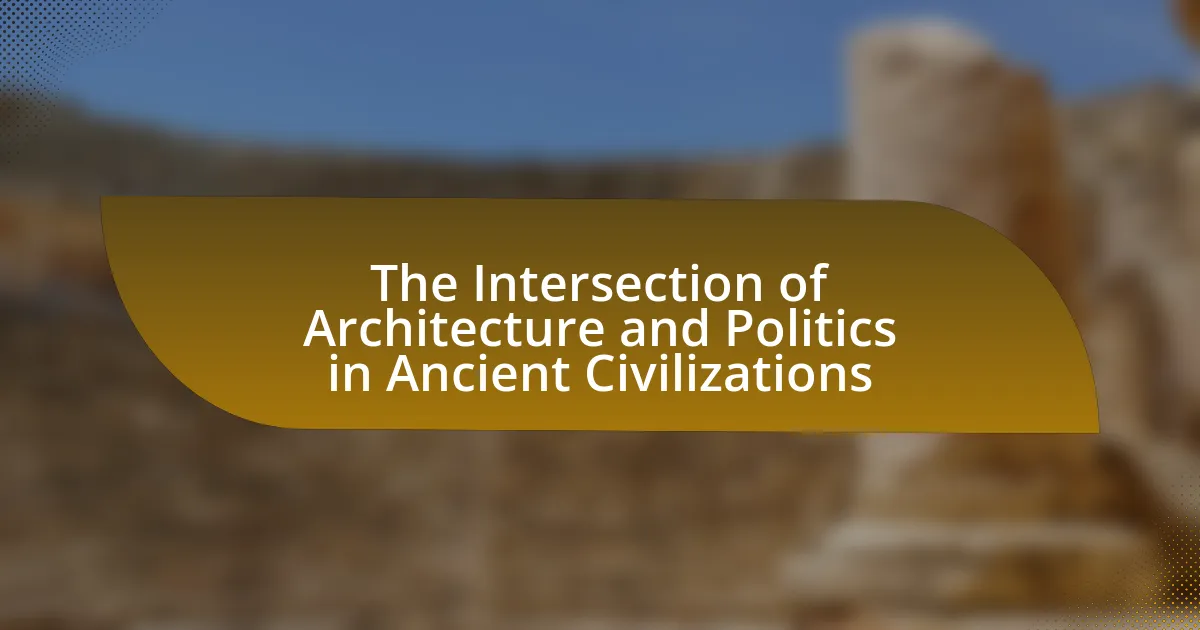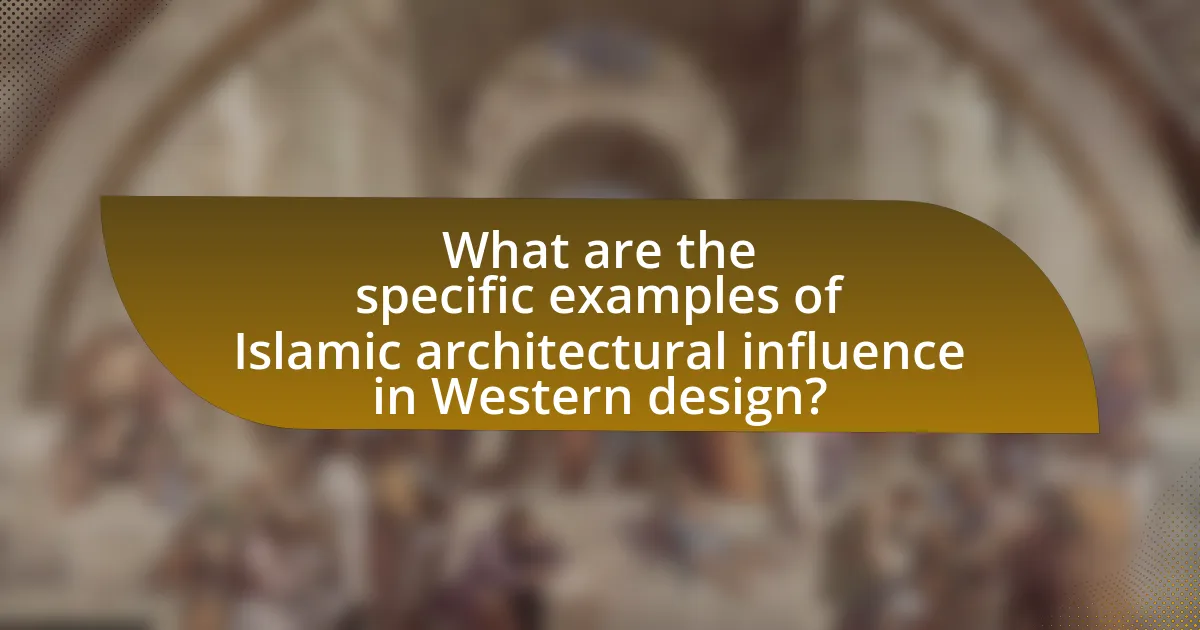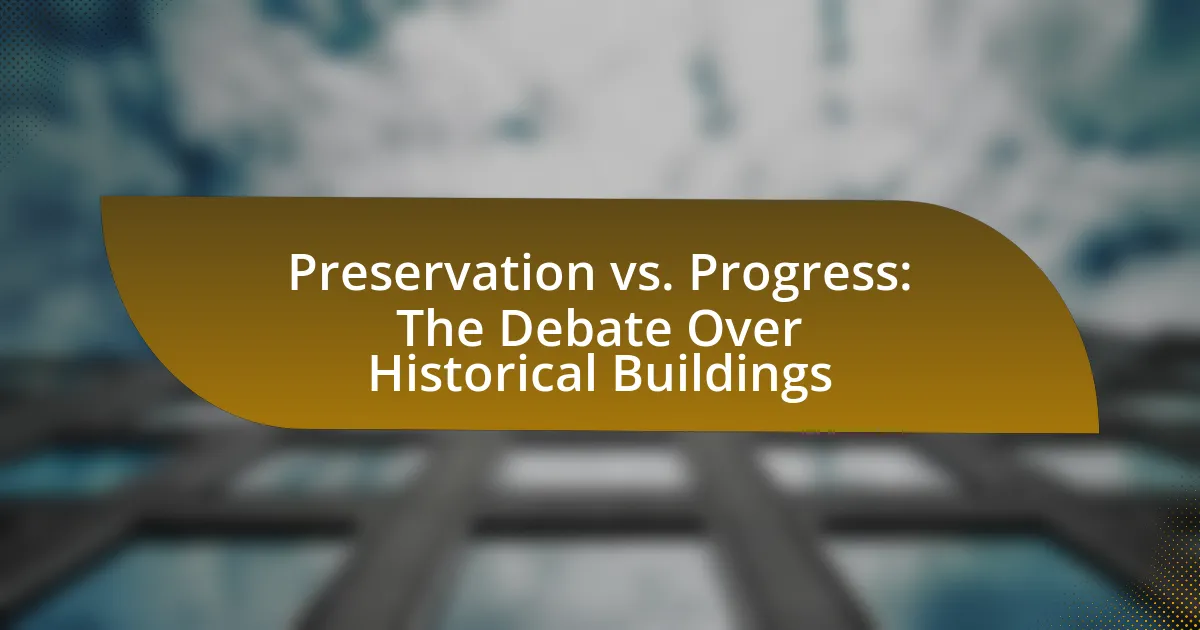Architecture serves as a vital component in shaping historical narratives by reflecting cultural values, societal structures, and significant events through its physical forms. This article explores how architectural styles, materials, and spatial organization convey historical contexts, influencing collective memory and identity. It examines the role of notable structures, such as the Parthenon and the Great Wall of China, in representing the ideals and struggles of their respective societies. Additionally, the article discusses the impact of urban planning and contemporary design on historical narratives, emphasizing best practices for architects to honor historical contexts in new constructions.

What is the Role of Architecture in Shaping Historical Narratives?
Architecture plays a crucial role in shaping historical narratives by serving as a physical manifestation of cultural values, societal structures, and historical events. For instance, monumental buildings like the Parthenon in Greece symbolize ancient democratic ideals, while the Great Wall of China reflects the historical emphasis on defense and unity. These structures not only provide insight into the technological advancements of their time but also influence collective memory and identity. Historical architecture often embodies the political and social dynamics of its era, as seen in the contrasting styles of Gothic cathedrals and Renaissance palaces, which represent shifts in power and ideology. Thus, architecture is integral to understanding and interpreting the complexities of history.
How does architecture influence our understanding of history?
Architecture influences our understanding of history by serving as a tangible representation of cultural values, technological advancements, and societal structures of different eras. For instance, the grandeur of ancient Roman architecture, exemplified by structures like the Colosseum, reflects the empire’s engineering prowess and social hierarchy, while Gothic cathedrals illustrate the medieval focus on spirituality and community. These architectural styles provide insights into the political, economic, and religious contexts of their time, allowing historians to interpret the past through the physical remnants left behind. Furthermore, the preservation and study of architectural sites contribute to our knowledge of historical events and daily life, as seen in archaeological findings that reveal urban planning and social organization in ancient civilizations.
What are the key elements of architecture that convey historical narratives?
Key elements of architecture that convey historical narratives include style, materials, symbolism, and spatial organization. Architectural style reflects the cultural and technological context of its time, such as Gothic cathedrals representing medieval Europe’s religious fervor. Materials used, like local stone or brick, often tell stories of regional resources and craftsmanship. Symbolism in architectural features, such as columns or domes, can signify power, democracy, or spirituality, as seen in structures like the Parthenon. Lastly, spatial organization, including layout and design, influences how people interact with the space, revealing societal values and historical events, such as the open plazas of ancient Rome that facilitated public gatherings. These elements collectively serve as a visual language that communicates the historical context and significance of a given period.
How do architectural styles reflect the cultural context of their time?
Architectural styles reflect the cultural context of their time by embodying the values, beliefs, and technological advancements of the society that produced them. For instance, Gothic architecture, characterized by its pointed arches and flying buttresses, emerged in the 12th century in Europe, reflecting the era’s emphasis on spirituality and the importance of cathedrals as centers of community life. This style was a response to the cultural desire for grandeur and the expression of religious devotion during the Middle Ages. Similarly, the use of modernist architecture in the early 20th century, with its emphasis on simplicity and functionality, mirrored the cultural shift towards industrialization and the rejection of historical styles, showcasing a society focused on progress and innovation. These examples illustrate how architectural styles serve as tangible representations of the cultural, social, and technological contexts of their respective periods.
Why is architecture considered a historical document?
Architecture is considered a historical document because it encapsulates the cultural, social, and technological contexts of the time in which it was created. Each structure reflects the values, beliefs, and practices of the society that built it, serving as a tangible representation of historical events and trends. For example, the construction of the Parthenon in ancient Greece illustrates the significance of democracy and religious devotion in that era, while the Gothic cathedrals of medieval Europe showcase advancements in engineering and the importance of faith. These architectural forms provide insights into the economic conditions, materials available, and artistic styles prevalent during their construction, making them essential for understanding historical narratives.
In what ways does architecture preserve historical events and figures?
Architecture preserves historical events and figures by serving as a physical representation of cultural heritage and collective memory. Notable structures, such as the Parthenon in Greece, commemorate significant historical events and honor influential figures, thereby embedding these narratives within the built environment. Additionally, architectural styles and monuments often reflect the socio-political context of their time, such as the Gothic cathedrals that symbolize the power of the Church during the Middle Ages. These structures not only provide a tangible link to the past but also facilitate public engagement with history, as seen in memorials like the Vietnam Veterans Memorial, which honors those who served and evokes collective remembrance.
How do architectural ruins contribute to our understanding of past societies?
Architectural ruins provide critical insights into past societies by revealing their cultural, social, and technological practices. These remnants serve as tangible evidence of architectural styles, construction techniques, and urban planning, which reflect the values and priorities of the civilizations that created them. For instance, the ruins of ancient Rome, such as the Colosseum and aqueducts, illustrate advanced engineering skills and the importance of public entertainment and infrastructure in Roman society. Additionally, archaeological studies of these sites often uncover artifacts and inscriptions that further contextualize the social dynamics, economic conditions, and religious beliefs of the time, thereby enriching our understanding of historical narratives.
What role does architecture play in collective memory?
Architecture serves as a physical manifestation of collective memory by embodying cultural values, historical events, and social identities. Structures such as monuments, memorials, and public buildings are designed to evoke memories and emotions associated with significant moments in a community’s history. For instance, the Vietnam Veterans Memorial in Washington, D.C., not only commemorates those who served but also facilitates collective mourning and reflection, reinforcing the shared experiences of a nation. This relationship between architecture and collective memory is supported by studies that show how built environments influence social cohesion and identity, as seen in the preservation of historical sites that serve as reminders of a community’s past.
How do monuments and memorials shape public perception of history?
Monuments and memorials shape public perception of history by serving as tangible representations of significant events, figures, or ideologies, thereby influencing collective memory. These structures often embody specific narratives that highlight particular aspects of history while omitting others, which can lead to a skewed understanding of the past. For example, the Lincoln Memorial in Washington, D.C., emphasizes themes of unity and freedom, reinforcing Abraham Lincoln’s legacy as a champion of civil rights, while potentially downplaying the complexities of his presidency and the ongoing struggles for racial equality. Additionally, research indicates that monuments can evoke emotional responses and foster a sense of identity among communities, as seen in the case of the Vietnam Veterans Memorial, which provides a space for reflection and healing for veterans and their families. Thus, monuments and memorials play a crucial role in shaping how history is perceived and remembered by society.
What impact does urban planning have on historical narratives?
Urban planning significantly influences historical narratives by shaping the physical environment in which historical events occur and are remembered. The design and layout of cities can highlight or obscure historical sites, thereby affecting public perception and understanding of history. For instance, the preservation of historical districts in cities like Boston and Philadelphia allows for the retention of cultural heritage, which reinforces narratives about American independence and urban development. Conversely, urban renewal projects that demolish historical buildings can erase important cultural memories, altering the narrative of a community’s past. This dynamic illustrates how urban planning decisions directly impact the collective memory and historical identity of a place.
How can we analyze the relationship between architecture and historical narratives?
Analyzing the relationship between architecture and historical narratives involves examining how built environments reflect, influence, and embody cultural and historical contexts. Architectural styles, materials, and spatial arrangements often serve as physical manifestations of societal values, power dynamics, and historical events. For instance, the construction of monumental structures like the Parthenon in ancient Greece not only showcases architectural innovation but also represents the political and cultural ideals of democracy and civic pride during that era. Furthermore, the preservation or destruction of architectural heritage can signify shifts in historical narratives, as seen in post-colonial contexts where colonial buildings are reinterpreted or repurposed to reflect new national identities. This analysis can be supported by historical documentation, architectural critiques, and case studies that illustrate how specific buildings have shaped or been shaped by the narratives of their time.
What methodologies are used to study architecture’s role in history?
The methodologies used to study architecture’s role in history include historical analysis, comparative studies, and interdisciplinary approaches. Historical analysis involves examining primary sources such as architectural plans, photographs, and written records to understand the context and significance of architectural developments. Comparative studies allow researchers to analyze architectural styles and practices across different cultures and time periods, revealing how architecture reflects societal values and historical events. Interdisciplinary approaches integrate insights from fields like sociology, anthropology, and art history, providing a more comprehensive understanding of how architecture influences and is influenced by historical narratives. These methodologies collectively contribute to a nuanced understanding of architecture’s impact on historical contexts and cultural identity.
What are some examples of architecture that have significantly shaped historical narratives?
The Parthenon in Athens, the Colosseum in Rome, and the Great Wall of China are examples of architecture that have significantly shaped historical narratives. The Parthenon symbolizes the power and culture of ancient Greece, representing democracy and artistic achievement. The Colosseum reflects the grandeur of the Roman Empire and its social dynamics, showcasing the importance of public entertainment and engineering prowess. The Great Wall of China embodies the historical struggle for unity and defense against invasions, illustrating the lengths to which civilizations will go to protect their sovereignty. Each of these structures not only serves as a physical landmark but also as a narrative device that conveys the values, struggles, and achievements of their respective cultures throughout history.
How did the Parthenon influence Western architectural thought?
The Parthenon significantly influenced Western architectural thought by establishing the principles of classical architecture, particularly through its use of proportion, symmetry, and the Doric order. Its design, characterized by harmonious proportions and meticulous attention to detail, set a standard for beauty and balance that has been emulated in various architectural styles throughout history. The Parthenon’s influence is evident in the neoclassical movement of the 18th and 19th centuries, where architects like Thomas Jefferson incorporated its elements into structures such as the Virginia State Capitol. This enduring legacy underscores the Parthenon’s role as a foundational reference point in the evolution of Western architecture.
What is the significance of the Great Wall of China in historical context?
The Great Wall of China is significant in historical context as a symbol of defense and national unity. Constructed primarily during the Ming Dynasty (1368-1644), it served to protect Chinese states from invasions by nomadic tribes from the north. The wall spans over 13,000 miles and reflects the military strategies and architectural advancements of its time. Its construction involved the labor of millions, showcasing the collective effort and resources of various dynasties, which underscores its role in shaping Chinese identity and historical narratives. The Great Wall is recognized as a UNESCO World Heritage Site, further solidifying its importance in global history and culture.
How can contemporary architecture reflect historical narratives?
Contemporary architecture can reflect historical narratives by integrating design elements, materials, and forms that pay homage to past architectural styles and cultural contexts. For instance, the use of traditional building materials, such as brick or stone, in modern designs can evoke a sense of historical continuity, while architectural features like arches or columns can reference specific historical periods. An example is the National Museum of African American History and Culture in Washington, D.C., designed by David Adjaye, which incorporates elements of African American history and culture into its contemporary form, thus narrating a historical story through its architecture. This approach not only preserves historical significance but also engages the public in a dialogue about the past, making history accessible and relevant in a modern context.
What are the challenges of integrating historical narratives into modern design?
Integrating historical narratives into modern design presents challenges such as balancing authenticity with contemporary aesthetics, ensuring cultural sensitivity, and addressing the diverse interpretations of history. Designers must navigate the tension between preserving historical accuracy and meeting modern functional requirements, which can lead to conflicts in design choices. For instance, incorporating elements from a specific historical period may clash with current design trends, making it difficult to create a cohesive visual identity. Additionally, cultural sensitivity is crucial; misrepresenting or oversimplifying historical narratives can lead to backlash from communities whose histories are being represented. Furthermore, the subjective nature of historical interpretation means that different stakeholders may have varying perspectives on what aspects of history should be highlighted, complicating the design process.
How can architects honor historical contexts in new constructions?
Architects can honor historical contexts in new constructions by integrating design elements that reflect the architectural styles, materials, and cultural significance of the surrounding historical environment. This approach ensures that new buildings resonate with the historical narrative of the area, fostering a sense of continuity and respect for the past. For instance, using local materials and traditional construction techniques can create a visual and tactile connection to the historical context. Additionally, architects can study the historical significance of existing structures and incorporate similar proportions, forms, and details into their designs. This practice not only preserves the character of the area but also enhances the overall aesthetic and cultural value of the new construction, as seen in projects like the renovation of the historic district in Charleston, South Carolina, where new buildings complement the city’s colonial architecture.
What best practices should architects consider when addressing historical narratives?
Architects should prioritize authenticity, context, and community engagement when addressing historical narratives. Authenticity ensures that designs reflect the true historical significance of a site, avoiding superficial interpretations. Context involves understanding the historical, cultural, and social background of the area, which can guide design decisions that resonate with local heritage. Community engagement is crucial, as involving local stakeholders can provide insights into the narratives that matter most to them, fostering a sense of ownership and connection to the architecture. For instance, the restoration of the historic district in Savannah, Georgia, exemplifies how architects integrated local history and community input to preserve the area’s unique character while enhancing its relevance in contemporary society.












































